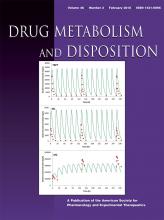Abstract
Orally administered probiotics change gut microbiota composition and enzyme activities. Thus, coadministration of probiotics with drugs may lead to changes in the pharmacokinetic parameters of the drugs. In this study, we investigated the pharmacokinetics of acetaminophen in mice treated with probiotics. Oral administration of probiotics changed the gut microbiota composition in the mice. Of these probiotics, Lactobacillus reuteri K8 increased the numbers of clostridia, bifidobacteria, and enterococci, and Lactobacillus rhamnosus K9 decreased the number of bifidobacteria, determined by culturing in selective media. Next, we performed a pharmacokinetic study of acetaminophen in mice orally treated with K8 and K9 for 3 days. Treatment with K8 reduced the area under the curve (AUC) of orally administered acetaminophen to 68.4% compared with normal control mice, whereas K9 did not affect the AUC of acetaminophen. Oral administration to mice of K8, which degraded acetaminophen, increased the degradation of acetaminophen by gut microbiota, whereas K9 treatment did not affect it. Treatment with K8 increased the number of L. reuteri adhered in the upper small intestine, whereas the number of L. rhamnosus was not affected by treatment with K8 or K9. K8 increased the number of cyanobacteria, whereas K9 increased the number of deferribacteres. These results suggest that the intake of probiotics may make the absorption of orally administered drugs fluctuate through the disturbance of gut microbiota-mediated drug metabolism and that the subsequent impact on microbiota metabolism could result in altered systemic concentrations of the intact drug.
Footnotes
- Received June 27, 2017.
- Accepted November 29, 2017.
J.-K.K. and M.S.C. contributed equally to this work.
This research was supported by a grant from the Ministry of Food and Drug Safety of Korea [16182MFDS416].
- Copyright © 2018 by The American Society for Pharmacology and Experimental Therapeutics
DMD articles become freely available 12 months after publication, and remain freely available for 5 years.Non-open access articles that fall outside this five year window are available only to institutional subscribers and current ASPET members, or through the article purchase feature at the bottom of the page.
|






